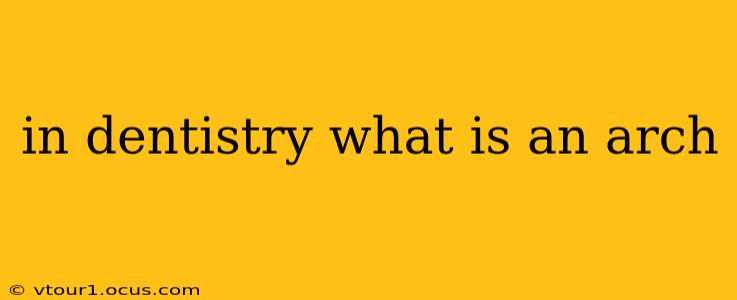Understanding Dental Arches: A Comprehensive Guide
In dentistry, an arch refers to the curved arrangement of teeth in either the upper or lower jaw. Think of it as the overall shape formed by your teeth when viewed from the front or top. Understanding dental arches is crucial for diagnosing and treating various dental conditions, from misalignment to gum disease. This guide will delve into the specifics of maxillary and mandibular arches, addressing common questions about their structure and importance.
What are the maxillary and mandibular arches?
The maxillary arch is the upper arch, encompassing the teeth embedded in the maxilla (upper jaw bone). The mandibular arch is the lower arch, containing teeth set within the mandible (lower jaw bone). These two arches work together, interacting during chewing, speaking, and swallowing. Their proper alignment is essential for optimal oral function and aesthetics.
What is the purpose of dental arches?
The dental arches serve several critical functions:
- Mastication (Chewing): The curved shape and arrangement of teeth within the arches facilitate the efficient grinding and breaking down of food. The opposing arches work in coordination to achieve this.
- Speech: The precise positioning of teeth in the arches is vital for clear articulation and pronunciation of sounds. Any malocclusion (improper bite) can affect speech.
- Facial Aesthetics: The shape and alignment of the dental arches significantly influence facial appearance. A well-aligned arch contributes to a balanced and attractive facial profile.
- Protection: The arches provide a protective barrier for the underlying tissues of the mouth and jaw.
How are dental arches formed?
Dental arch development is a complex process that begins in early childhood and continues through adolescence. The shape and size of the arches are influenced by genetic factors, environmental factors (such as thumb sucking), and overall growth patterns. Problems during this developmental phase can lead to malocclusion.
What are common problems associated with dental arches?
Several issues can affect the health and alignment of dental arches, including:
- Crowding: When there's insufficient space within the arch to accommodate all the teeth, leading to overlapping and crooked teeth.
- Spacing: Excessive spacing between teeth within the arch.
- Malocclusion (bad bite): Improper alignment of the upper and lower arches, resulting in an overbite, underbite, or crossbite.
- Dental Arch Collapse: Loss of teeth can lead to a collapse of the arch, shifting the remaining teeth. This often requires orthodontic intervention to restore proper alignment.
What treatments address dental arch problems?
Various treatments can address issues related to dental arches, depending on the specific problem and severity:
- Orthodontics (Braces or Invisalign): Used to correct malocclusion and improve the alignment of teeth within the arches.
- Extraction: In cases of severe crowding, extraction of certain teeth might be necessary to create space for proper alignment.
- Restorative Dentistry: Used to replace missing teeth and restore the shape and function of the arch. Dental implants, bridges, and dentures are common restorative options.
How can I maintain healthy dental arches?
Maintaining healthy dental arches involves practicing good oral hygiene:
- Regular brushing and flossing: Remove food particles and plaque to prevent gum disease and tooth decay.
- Regular dental checkups: Allow your dentist to monitor the health of your teeth and gums and address any potential problems early on.
- Healthy diet: A balanced diet low in sugar contributes to strong teeth and gums.
By understanding the structure and function of dental arches, individuals can take proactive steps to maintain their oral health and address any concerns promptly. Consulting a dentist regularly is crucial for preventing and treating problems associated with dental arches.
